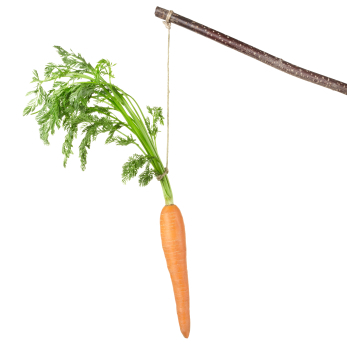 In his book, “Drive,” Daniel Pink tells of motivational research done with young children and their desire to draw. Given free time in a room with paper and crayons the children would all draw at their leisure. The experimenters then added extrinsic motivation to one group of children but not the other. The extrinsic motivation (or “carrot”) came in the form of offering money for each drawing the kids produced. The results of this were very predictable. As you can imagine, the children in the paid group produced more drawings. But, the experiment didn’t stop there, and in my opinion the next part of the experiment is where things got interesting. It did not take long for this “reward based” exercise to lead to a loss of intrinsic motivation. The kids in the paid group stopped drawing during the free periods when no payment was offered. By contrast, the kids in the non-paid group would continue drawing the whole time just for the love of drawing. Further study found that simply praising the children helped build drive and did not have the diminishing effect that money did. They also found that rewards which came unexpectedly and after the fact worked very well to build drive with no intrinsically corrosive effects. Note, unexpectedly, that was a biggie. Even coming after the fact, if rewards became expected the intrinsic decline would begin. Rewards that were offered in advance increased drive temporarily but when external rewards where removed motivation dwindled.
In his book, “Drive,” Daniel Pink tells of motivational research done with young children and their desire to draw. Given free time in a room with paper and crayons the children would all draw at their leisure. The experimenters then added extrinsic motivation to one group of children but not the other. The extrinsic motivation (or “carrot”) came in the form of offering money for each drawing the kids produced. The results of this were very predictable. As you can imagine, the children in the paid group produced more drawings. But, the experiment didn’t stop there, and in my opinion the next part of the experiment is where things got interesting. It did not take long for this “reward based” exercise to lead to a loss of intrinsic motivation. The kids in the paid group stopped drawing during the free periods when no payment was offered. By contrast, the kids in the non-paid group would continue drawing the whole time just for the love of drawing. Further study found that simply praising the children helped build drive and did not have the diminishing effect that money did. They also found that rewards which came unexpectedly and after the fact worked very well to build drive with no intrinsically corrosive effects. Note, unexpectedly, that was a biggie. Even coming after the fact, if rewards became expected the intrinsic decline would begin. Rewards that were offered in advance increased drive temporarily but when external rewards where removed motivation dwindled.
This really got me thinking about how motivation is approached in dog training. Are treats like money? Does training with external rewards diminish motivation in the long run like it did with these children? Where does punishment fit into this? Can dogs be trained without the use of carrots or sticks? Mr. Pink’s book, although not about dogs, is a great read and pondering it brought clarity to, and left a permanent mark on, my training style. Perhaps a little pondering can do us all some good. Learning never stops and we will never know it all. So below are my current thoughts, I hope you find them interesting.
in·trin·sic: motivation based on taking pleasure in an activity rather than working towards an external reward.
ex·trin·sic: when motivation comes from outside, such as performing for money or awards.
The dog training world is generally focused on “carrots and sticks” for motivation. Do this and you get cookie – do that and you’ll get squirted with water. There is a much heated debate over which is better. In truth, both can be effective but both are also extrinsic in nature. Extrinsic motivation, be it positive or negative, can come with a cost. Namely, that cost is diminished or undeveloped intrinsic motivation. There is plenty of information out there on the downside of punishment based or “stick” training. This is not surprising as it’s easy to imagine how training strictly through aversive methods could have a negative effect. What’s generally not mentioned, and might come as a shock, is that reward based or “carrot” training can have a negative impact as well. Even more shocking is that this is at its most exaggerated when done with a clicker and in a hands-off style.
“Wow, really?” You may ask, “isn’t the main point of clicker training that it’s motivational?” Yes, it is motivational, absolutely, and gentle too. No one can argue that, but if you really analyze it you will find it to be very extrinsic. Treats are already an external reward and then a clicker, being an unnatural and non personal sound, takes it even a step further outside. Add to that a focus on being hands-off and you can start to catch my drift. Although the intention of being hands-off is to train without force, the focus on clickers, treats and no touching can easily lead to no touching as a reward either. Even the well-intentioned can miss the mark if they’re not aware that this mark exists, so please join me in a new view of carrots, sticks and beyond.
Carrot People and Stick People
Stick People: “Traditional” or “Compulsion-Based” training focuses on compliance through punishment, and does achieve it, but can miss the mark as far as the dog’s joy is concerned. The dog may obey but may not enjoy it. He also may become collar wise, not obeying or behaving in the absence of a training collar or leash.
Carrot People: “Modern” or “Positive Only” training strives to be the antithesis of Traditional training by using liberal amounts of positive reinforcement, generally through food rewards. This does a great deal to create a dog that enjoys the process but unfortunately this can backfire when it comes to intrinsic motivation. It can become “all about the money” so to speak…..no treat = no performance.
What About Being a “Dog Person”?
Going beyond carrots and sticks is about the dog working for the joy of it.
- Because dogs like us and want to please or participate.
- Because dogs are pack animals and are hard wired to be a part of a group.
- Because dogs are prey animals and instinctively like to work.
- Because dogs thrive on structure and crave leadership.
This is powerful stuff that often gets overlooked or overshadowed by a focus on external rewards and punishments.
So, am I saying to train without rewards or punishment? Is that even possible? No, of course not. What I’m suggesting is that rewards and punishments don’t always have to be carrots and sticks. They can be more intrinsic in the form of relationship, your approval or disapproval. Your voice, hands, body language and overall presence can have an intrinsic value much more intimate, profound and longer lasting than external rewards and punishments.
“This sounds great but it doesn’t work with my dog!”
I’m sure that some readers at this point are experiencing doubt or a desire to debate. That’s because carrots and sticks have been used to motivate animals (and humans) since time immemorial. Why? Because they are easy to use, they require little to nothing in the way of relationship and quite frankly, they work. They work great in the short term, providing observably instant results. They work to motivate the less than self-motivated and when intrinsic motivation is nowhere to be found. But, when intrinsic motivation is available, extrinsic motivators can cause a good deal of damage to it. Fortunately, this can be avoided with a dose of awareness.
Two Keys to Using Extrinsic Rewards Without Harming Intrinsic Motivation.
Use Only as Needed
Avoid extrinsic motivators if an effective intrinsic motivator is available.
- Don’t use treats if praise or petting will do.
- Don’t use correction devices if a firm tone or body block will do.
- Wean off or minimize training tools ASAP to avoid negative fallout.
Use To Create or Enhance Intrinsic Motivation
Use food lures as a means to build drive or reduce resistance
- Dog may be resistant to a new exercise, situation or handler.A dog may not want affection at first. Treats can build a bridge towards a more enjoyable experience.
- Use verbal praise and/or petting while giving the treat. This puts more of you into the reward process.
- Fade food lures as quickly as possible
- Empty hand signal or verbal cue with treat coming after the correct response.
- Then only give treat rewards randomly and unpredictably.
- Give a verbal command BEFORE delivering a correction.
- Allows the dog a chance to learn and to avoid punishment, hence empowering and building respect for you, not the tool.
- “Don’t bite if a growl will do.” If dog responds to verbal command then there should be no physical punishment.
- Follow correct responses with praise and gratitude and redirect to a wanted behavior.
Let’s Put This Theory To The Test
Like me, you have likely been training your dog with some combination of “carrots and sticks” and with some degree of success. The point of this article is not to abandon these things completely, particularly if they have been effective. The thing that I am hoping you will take away from this is the idea of putting more of yourself into your dog training. Taking a step back you may find that the carrots and sticks have become crutches that you no longer need. So in closing just consider trying this simple exercise:
For the next week, forgo all training tools. No treats, no toys, no training collars and (when possible) not even a leash. Just you and your dog (in a safe environment of course). See what happens. You may be surprised at how well it goes. You may also find yourself having to rise to some new challenges such as being more animated, exciting and creative. You may have to work a bit harder to achieve and maintain your dog’s attention but in the long run, I am willing to bet you will have a better bond, more fun and new lease on life with your dog.
-Chad Culp, Certified Dog Trainer and Canine Behavior Consultant
© Thriving Canine 2013



